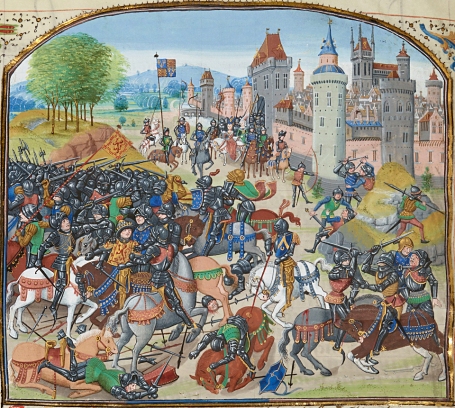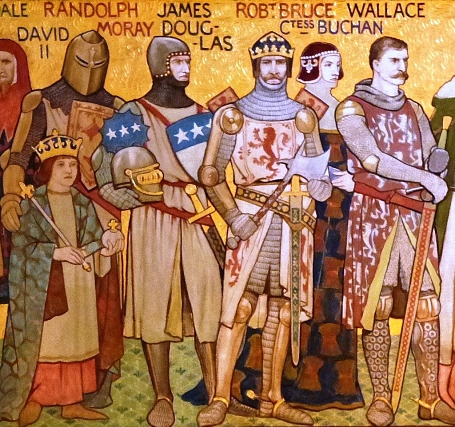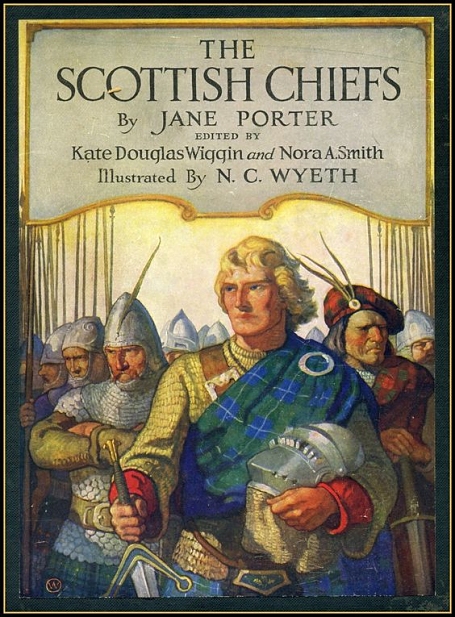The Life and Heroick Actions of the Renoun'd Sir William Wallace,
General and Governour of Scotland
by William Hamilton of Gilbertfield
Book VIII, Chapter II (Continued)
How Corspatrick brought into Scotland Bishop Beik and Robert Bruce, and how WALLACE gave them battle, and put them out of Scotland
Crawford of Edinburgh, brought with him on sight
Four Hundred Men, all in their Armour bright.
From Teviotdale came many a good Man,
From Jedburgh also with what Speed they can.
Sir William als, the Lord of Douglass, came
With Fourscore Men of most undoubted Fame.
Two Thousand fresh new Men, do there propose,
A full Revenge that Night upon their Foes.
Wallace's Watches all good Men and true,
Attentively the South'ron's Quarters view.
Then after Supper Wallace quietly,
To Lammer-moor march'd with his Cavalrie,
Sir John the Graham, and Seatoun, that good Hand,
Lauder, and Hay, Three Thousand did Command.
The Rest himself most wisely he did guide,
With him was Douglas, Ramsay, Barclay, and Boyd.
Richard of Lundie, a bold Man and stout,
And Adam Wallace, whom no Man durst doubt.
Who by the Time the Sun was come in Sight
Surpris'd the English, unprepar'd for Fight.
And furiously, with Sword in Hand cut down,
Many a Proud and Saucie South'ron Lown.
Some rose confus'dly and some fled away,
Some on the Ground were smoored where they lay.
Great Noise, and Cry arose, all round about,
Then came Sir John the Graham both Bold and Stout;
With his brave Men, all cheerful, blyth and glad,
At Sight of whom, Ten Thousand South'ron fled.
Yet Bishop Beik, behav'd well in that Throng,
And in the Fight continued very long.
One Skeltoun there that was an English Knight,
Before him stood, in shining Armour bright;
To save his Lord, he fought most valiantly,
Whom, there so soon as Lundie did espy;
With his good Sword, a backward Stroak he gave
Which kill'd the English Knight, both stout and brave.
Then fled they all, no longer durst abide,
Patrick, and Beik, away with Bruce do ride.
Who with Five Thousand, took the readiest Way
To Norham House; with all the Speed they may.
The Scots, who were both able, young and tight,
Pursu'd and kill'd great Numbers in the Flight.
Thus Twenty Thousand South'ron in a Word,
In Flight, and Battle, perish'd by the Sword.
Wallace returns from Norham, without more,
But for the Bruce, his Heart was mighty sore.
Whom he had rather seen the Crown enjoy,
Than Master been of all the Gold in Troy.
O'er Patrick's Lands, Wallace he marched fast,
Took out the Goods, and Castles down did cast.
He Twelve of them, that Methamis they call
Broke quickly down, and them destroyed all.
Within the Merse and Lowthian left he none,
To him belong'd, except Dunbar alone.
To Edinburgh then, he march'd on the Eighth Day,
And on the Morrow, he without Delay,
Unto St. Johnstoun very quickly past,
And told the Barrons all from First to Last
How sacredly he keeped had his Vow,
And got a Master to Corspatrick now.
Who said of late, that he as free did Reign
In this Realm, as either Prince, or King.
Of what he's won, need's not great Boasting make,
Let him come back, and now take up his Stake.
Great Thankfulness the Lords did there express
To Providence, for Wallace good Success.
Then Wallace with an open lib'ral Hand,
To Men deserving dealt the Rebel's Land.
To his own Kin no Heritage gave he,
But Offices that ev'ry Man might see,
All he propos'd, was this one very Thing,
The Nation's Peace, and Honour of his King.
For which he would abide and stand the Law.
So soon as he, his King and Master saw,
Now Old and Young, the Girl and the Boy;
Have Peace and Rest, and clap their Hands for Joy.
The ballad, The Life and Heroick Actions of the Renoun'd Sir William Wallace, General and Governour of Scotland, by William Hamilton of Gilbertfield, 1722, is in the public domain.

The Kingdom of England and the Kingdom of Scotland fought dozens of battles with each other. They fought typically over land, particularly Berwick-Upon-Tweed, and the Anglo-Scottish border frequently changed as a result. Read more at Wikipedia.

The First War of Scottish Independence was the initial chapter of engagements in a series of warring periods between English and Scottish forces lasting from the invasion by England in 1296 ... Read more at Wikipedia.

Digitized version of The Scottish Chiefs, by Jane Porter, a novelization published in 1921 by Charles Scribner's Sons, about William Wallace and the First Scottish War of Independence. Read online at archive.org.